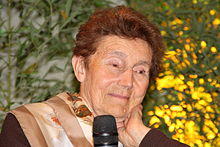Hélène Langevin-Joliot
Hélène Langevin-Joliot | |
|---|---|
 Hélène Langevin-Joliot (2012) | |
| Born | 17 September 1927 |
| Nationality | French |
| Citizenship | France |
| Scientific career | |
| Fields | Physics |
| Institutions | CNRS |
| Notes | |
Parents: Irène Joliot-Curie and Frédéric Joliot
Grandparents: Marie and Pierre Curie Great Uncle: Józef Skłodowski Great Aunts: Zofia Skłodowska, Bronisława Skłodowska, and Helena Skłodowska.[1] | |
Hélène Langevin-Joliot (born 17 September 1927) is a French nuclear physicist. She was educated at the IN2P3 (English: Institute of Nuclear Physics and Particles) at Orsay, a laboratory which was set up by her parents Irène Joliot-Curie and Frédéric Joliot-Curie. She is a member of the French government's advisory committee.[2] Currently, she is a professor of nuclear physics at the Institute of Nuclear Physics at the University of Paris and a Director of Research at the CNRS. She is also known for her work in actively encouraging women to pursue careers in scientific fields.[3][4] She is Chairperson of the panel that awards the Marie Curie Excellence award, a prize given to outstanding European researchers.[5] She was President of the French Rationalist Union from 2004 to 2012.[6]
Family
Langevin-Joliot comes from a family of well-known scientists.
- Her maternal grandparents were Marie and Pierre Curie, famous for their study of radioactivity, for which they won a Nobel Prize in physics with Henri Becquerel in 1903. (Marie Curie was also the first person to win a Nobel Prize in two sciences, the second being for chemistry (1911) with her discovery of radium and polonium.)
- Her parents, Jean Frédéric Joliot-Curie (born Jean Frédéric Joliot) (who was mentored by Marie) and Irène Joliot-Curie (born Irène Curie), won a Nobel Prize for chemistry in 1935 for their discovery of artificial radioactivity.
- Her brother Pierre Joliot is a noted biophysicist who has made contributions to the study of photosynthesis.
In response to her family's legacy, Langevin-Joliot regularly grants interviews and gives talks about their history.[4][7] Her knowledge of her family's history led to her writing the introduction to Radiation and Modern Life: Fulfilling Marie Curie's Dream, including a brief history of the Curies.[8]
Her husband, Michel Langevin, was grandson of the famous physicist Paul Langevin (who had an affair with the widowed Marie Curie, Hélène's grandmother, in 1910) and was also a nuclear physicist at the Institute; her son, Yves (b. 1951), is an astrophysicist.[7][9]
References
- ^ "Marie Curie – Polish Girlhood (1867–1891) Part 1". American Institute of Physics. Retrieved 7 November 2011.
- ^ "Rencontre avec Hélène Langevin-Joliot" (in French). canslup.unilim.fr. Retrieved 2010-02-03. Google translation
- ^ "Madam {sic} Curie's Legacy". best.me.berkely.edu. Retrieved 2007-01-17.
- ^ a b "An Interview with Hélène Langevin-Joliot, the Granddaughter of Pierre and Marie Curie". Archived from the original on 2007-09-27. Retrieved 2007-04-06.
- ^ "First EU Marie Curie Awards in recognition of world-class achievements in European research". Retrieved 2007-04-06.
- ^ "Union rationaliste – Qui sommes-nous ?" (in French). union-rationaliste.org. Retrieved 2007-04-12.
- ^ a b "Marie & Pierre Curie's granddaughter, Hélène Langevin-Joliot, visits the United States". Eurekalert.org. Retrieved 2007-01-17.
- ^ "Radiation and modern life Fulfilling Marie Curie's dream". Retrieved 2007-04-06.
- ^ "Family Records". Archived from the original on 2007-09-27. Retrieved 2007-01-24.
